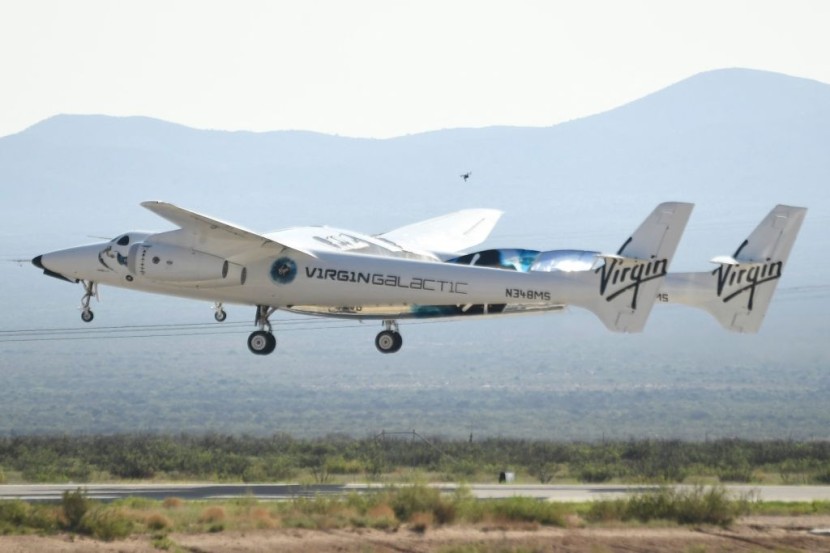
Virgin Galactic is scheduled to fly paying customers for the first time aboard its SpaceShipTwo vessel VSS Unity to the edge of space Thursday, June 29.
Weather permitting, the company plans to send a three-man crew from Italy alongside an instructor and two pilots on a suborbital ride about 50 miles (80km) above the earth's surface.
TOMORROW, we're launching The Spaceline for Earth with #Galactic01, our first scientific research mission! You can watch the moment live at 9:00 am MDT | 11:00am EDT. Sign up so you don't miss it: https://t.co/5UalYTpQxj pic.twitter.com/D7mBX8wDcH
— Virgin Galactic (@virgingalactic) June 28, 2023
The mission was dubbed "Galactic 01" owing to the fact that this would be the first time paying customers would be flying aboard the Unity, which would initially be lifted by its mothership, the VMS Eve.
The flight marks a decisive moment for Virgin Galactic as it inaugurates its commercial spaceflight service following several years of development setbacks and a tragic incident in 2014, after losing its vehicle VSS Enterprise and the death of its pilot Michael Alsbury.
Enterprise's commander, Peter Siebold, was also seriously injured. The Virgin Galactic flight follows the Virgin Group's recent decision to cease the operation of its plane-launched rocket subsidiary Virgin Orbit after multiple launch failures in the UK. Virgin Orbit filed for bankruptcy earlier this year and has subsequently sold off all its assets to multiple commercial spaceflight companies.
We are wired to wonder. And when we open access to space to more people like researchers and scientists from @ItalianAirForce & @CNRsocial_, we have the power to unlock our potential here on Earth. Join us TOMORROW at 9:00 am MDT | 11:00 am EDT to watch #Galactic01 live:… pic.twitter.com/ZeC4bQnpTz
— Virgin Galactic (@virgingalactic) June 28, 2023
The Galactic 01 Crew
The Italian crew members were identified as the following: Air Force Col. Walter Villadei, whose participation would be part of his astronaut training for a future mission to the International Space Station; Air Force Lt. Col. Angelo Landolfi, a physician and designated flight surgeon for the mission; and Pantaleone Carlucci, an engineer at the National Research Council of Italy (CNR).
The Unity would be piloted by Mike Masucci (commander) and Nicola Pecile (pilot). Flight trainer Colin Bennett, who flew with Virgin Group boss Richard Branson in 2021, would also be onboard.
Piloting the Eve would be Kelly Latimer (commander) and Jameel Janjua (pilot).
Flight Sequence
Eve will lift the Unity when it takes off at around 11:00 Eastern Time Thursday (15:00 UTC) from Spaceport America near the New Mexico town of Truth or Consequences.
Unity will separate from Eve at an altitude of 9.5 miles (15.24 km) and fire its engines in a near-vertical climb at Mach 3 or three times the speed of sound. Once the craft reaches the apogee of between 50 and 55 miles (80-89 km), the crew would experience a few minutes of weightlessness before the Unity re-enters the thicker part of the atmosphere and glides back to the spaceport for a runway landing.
The whole flight, if successful, would only last about 90 minutes. The next flight, Galactic 02, would take place in August, with Virgin promising a monthly cadence of flights.
'Edge of Space' Issue against Blue Origin
Global standards from the International Aeronautical Federation (FAI) determine 62 miles (100km) as the altitude needed to reach space and is colloquially known as the Karman Line. However, the National Aeronautics and Space Administration (NASA) and the US military reckon the 50-mile mark as the edge of space.
Blue Origin, Virgin's main competitor, launches its New Shepard rocket to an altitude of 62 miles in adherence to the international demarcation line. Virgin's Unity, on the other hand, can only fulfill the American standard so far.
Buona fortuna Virgin Galactic e Aeronautica Militare! Wishing the crew of @VirginGalactic's upcoming Galactic 01 space mission the best of luck - from the #VirginFamily in Italy and beyond. 🚀 #Galactic01 #VirginGalactic @VirginFibra @vVirginActiveIT @VirginRadioIT pic.twitter.com/gSj8cCBy6i
— Richard Branson (@richardbranson) June 27, 2023
Virgin Galactic's Stock Skyrockets Ahead of Flight
Meanwhile, Virgin Galactic's stock rose 3.4% in premarket trades as the company is preparing for the flight of the Galactic 01 mission Thursday.
The company's stock has been skyrocketing over the past few days after it gained 27.1% on June 20 and 9.2% Wednesday (June 28).
Virgin Galactic charges paying passengers $450,000 per seat aboard the Unity, saying they have received around 800 customers since they opened the program to the public. The company additionally announced last week that they are seeking to raise $400 million to develop its spaceship fleet and infrastructure, as well as scale its commercial operations.








